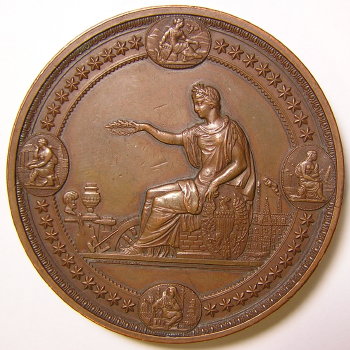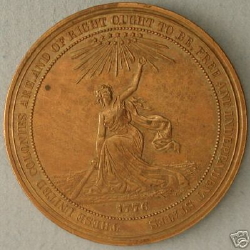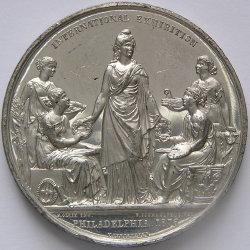About 12,000 of these identical 3 inch bronze award medals were awarded at the 1876 Centennial Exposition according to this report “by “A Centennial Cabinet” by Ron Abler. However, there are three versions of the medals as well as some privately produced award medals. One version is a 4 inch bronze medal and another version is a 4 inch silver medal which was the ordinal design plan, but after producing a few of this size, this medal size was stopped because of production problems and the 3 inch diameter medals was produced as the main award medal.
1876 Exposition Award Medals Examples

1876 PHILADELPHIA INTERNATIONAL EXHIBITION BRONZE AWARD MEDAL
AWARDED BY UNITED STATES CENTENNIAL COMMISSION IN 1876.
Text on obverse, under left foot. Designed by: H Mitchell SC Copper, 3 inch, 285.0 gm, rim 9.9 mm thick. Features a central female figure, who is likely an allegorical representation of America or Liberty. She is depicted seated and extending her right arm outward, in a gesture that may symbolize the act of presenting or welcoming. Vignettes are set within a circular border, which is itself enclosed by an outer ring adorned with stars. The stars could represent the states of the Union at that time. The border of the medal features the inscription “INTERNATIONAL EXHIBITION” at the top and “PHILADELPHIA MDCCCLXXVI” at the bottom, with the Roman numerals translating to the year 1876.

1876 PHILADELPHIA INTERNATIONAL EXHIBITION BRONZE AWARD MEDAL
Copper, 76 mm, 285.0 gm, rim 9.9 mm thick. The reverse side of the 1876 Philadelphia International Exhibition bronze award medal is relatively simple and dignified, focusing on text within a central field surrounded by a wreath. The inscription reads “INTERNATIONAL EXHIBITION” at the top, followed by “AWARDED BY UNITED STATES CENTENNIAL COMMISSION,” indicating the body responsible for presenting the award. The date of the exposition, “PHILADELPHIA MDCCLXXVI,” is inscribed at the bottom, with the year in Roman numerals signifying 1876. The medal’s entire design, with its elegant wreath and clear inscriptions, celebrates the contributions and innovations that were recognized during America’s centennial festivities.

1876 PHILADELPHIA INTERNATIONAL EXHIBITION 4 INCH BRONZE AWARD MEDAL
1876 Large Award Medal. Inscribed to recipients on reverse. 4-inch award medal, very few issued.

1876 PHILADELPHIA INTERNATIONAL EXHIBITION BRONZE AWARD MEDAL
1876 Large Award Medal. Inscribed to recipients on reverse. 4-inch award medal, very few issued.

1876 PHILADELPHIA INTERNATIONAL EXHIBITION SMALL BRONZE AWARD MEDAL
1876 Small Award Medal

1876 PHILADELPHIA INTERNATIONAL EXHIBITION SMALL BRONZE AWARD MEDAL
1876 Small Award Medal
Official Medals of the US Centennial Exposition
Official Medals – Authorized by Congress and struck in the Mint Exhibit at the Exposition. Silver 10,133 struck, Bronze 13,000 struck, Gilt 10,500 stuck.

Silver Official US Centennial Expo Medal
1876 OFFICIAL CONGRESS CENTENNIAL SILVER MEDAL SO CALLED DOLLAR RARE
HK-20 in Silver. 38mm.24.7 grams.

Silver Official US Centennial Expo Medal
1876 OFFICIAL CONGRESS CENTENNIAL SILVER MEDAL SO CALLED DOLLAR RARE
HK-20 in Silver. 38mm.24.7 grams.

U.S. Centennial Expo 1876 H&K 22 Gilt
The official medal in Gilt.

U.S. Centennial Expo 1876 H&K 22 Gilt

U.S.1876 Official Bronze Medal Centennial Expo 1876 H&K 22 Gilt
1776 CENTINNIAL EXPOSITION MEDALS HK 21 SO-CALLED DOLLAR 1876 U.S. CENTENNIAL EXPOSITION
the official medal from the 1876 Centennial Exposition, graded Choice About Uncirculated. Nice Bronze reflective surfaces. Authorized by Congress and struck in the Mint Exhibit at the Exposition. Item #5801051506

U.S.1876 Official Bronze Medal Centennial Expo 1876 H&K 22 Gilt
1776 CENTINNIAL EXPOSITION MEDALS HK 21 SO-CALLED DOLLAR 1876 U.S. CENTENNIAL EXPOSITION
the official medal from the 1876 Centennial Exposition, graded Choice About Uncirculated. Nice Bronze reflective surfaces. Authorized by Congress and struck in the Mint Exhibit at the Exposition. Item #5801051506
More Expo Medals of the US Centennial Exposition

DECLARATION OF INDEPENDENCE DOLLAR HK-74 – White Metal. 43mm.
Obverse: Copy of John Trumbull’s painting of 1776 Congress; Committee of Five making its report on Declaration (heads facing); above The Declaration; below of Independence, 1776

DECLARATION OF INDEPENDENCE DOLLAR HK-74 – White Metal. 43mm.
Reverse: In / Commemoration / of the / Centennial / of / Colonial / Independence / 1876; at top, around United States of America; bottom edge around, microscopic Pat. Nov. 3, 1874 H&L

1876 Danish Medal Centennial Exhibition. Baker-426B
1876 Danish Medal Centennial Exhibition. Baker-426B. Rarity-4. Danish Medal. White metal. 780.9 grains; 52.6 mm. Proof-63. Bright and reflective Proof fields, the devices being lightly frosted. A beautiful example of this popular medal.
The dies were prepared by J. Ohlrik, and the medals were made by F. Schmahlfeld. This is one of the larger, more elegant medals of the 1876 Centennial Exhibition.

1876 Danish Medal Centennial Exhibition. Baker-426B
1876 Danish Medal Centennial Exhibition. Baker-426B. Rarity-4. Danish Medal. White metal. 780.9 grains; 52.6 mm. Proof-63.
More About the1876 Centennial Exposition Medal Awards
The 1876 Centennial Exposition, held in Philadelphia, marked the 100th anniversary of the United States’ independence and was a showcase of American culture and industry. Here’s a closer look at the awards and some of the notable recipients who received medals:
Award Medal Categories:
The Centennial Exposition’s awards were divided into several broad categories that reflected the industrial and cultural spirit of the time:
Agriculture: Honoring advancements in farming machinery, techniques, and produce.
Manufacturing: Recognizing innovation in the manufacturing processes and the quality of finished goods.
Education and Science: For contributions to educational materials, scientific discoveries, and technological inventions.
Art: Awards for achievements in painting, sculpture, and other fine arts.
Machinery: For new developments in industrial machinery and tools.
Horticulture: Recognizing excellence in botanical exhibits and gardening innovation.
Criteria for Medal Recipients:
The Centennial Exposition awards were granted based on:
Innovation and Originality: New and original contributions to the field were highly prized.
Design and Craftsmanship: The aesthetic and functional design of the products displayed.
Practical Utility: The usefulness and practical application of the exhibits.
Scientific Achievement: Contributions to science that could further industrial or cultural progress.
Spotlight Stories of Award Winners
One notable recipient was Alexander Graham Bell, who received a Centennial Medal for his invention of the telephone, which he demonstrated at the exposition. This invention would go on to revolutionize global communication.
Another highlight was the Remington Typewriter Company, which showcased the Sholes and Glidden typewriter, receiving recognition for this innovation that would become indispensable in business.
The Corliss Steam Engine, a giant and powerful steam engine exhibited by George H. Corliss, also received accolades. It was the centerpiece of Machinery Hall and powered many of the exhibits, symbolizing the industrial might of the nation.
Lastly, a special mention could go to the Japanese Pavilion, which was awarded for its introduction of Japanese culture and arts to the American public, profoundly influencing American aesthetics and design, particularly in the Aesthetic Movement.
Among the attendees were some of the era’s most influential personalities
These awards and their recipients exemplify the spirit of innovation and cultural exchange that the 1876 Centennial Exposition celebrated, setting the stage for the future of American industry and arts.
The 1876 Centennial Exposition in Philadelphia was not only a showcase of innovation but also a gathering of notable figures from various fields. Among the attendees were some of the era’s most influential personalities:
- Alexander Graham Bell: He introduced the telephone to the public at the Centennial Exposition. His demonstrations brought him to the attention of powerful financiers who would help him found the Bell Telephone Company.
- Thomas Edison: While not yet the famed inventor he would become, Edison attended the exposition where he would have seen the latest technological innovations, possibly influencing his future work.
- Ulysses S. Grant: The President of the United States at the time, Ulysses S. Grant, along with Emperor Dom Pedro II of Brazil, presided over the exposition’s opening ceremony.
- Susan B. Anthony: The Centennial Exposition was also a platform for social reformers like Susan B. Anthony, who distributed pamphlets and advocated for women’s rights.
- John Philip Sousa: The musician, who would later become famous as the “March King,” performed at the exposition as a conductor of the United States Marine Band.
- Joseph Henry: The first Secretary of the Smithsonian Institution, Joseph Henry, was involved in planning the exposition and ensuring the event’s educational quality.
- Emperor Dom Pedro II of Brazil: His presence was a testament to the international importance of the exposition. He was known for his interest in science and technology, making the exposition particularly appealing to him.
These figures, among many others, contributed to the fair’s atmosphere of cultural exchange, intellectual collaboration, and societal progression. The interaction of such a diverse group of luminaries no doubt spurred conversations and ideas that influenced the course of American history.
